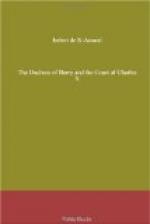In a very interesting work, the Vie de Charles X. by the Abbe de Vedrenne, the reader will find:—
“By the marriage of Sophie Dawes, did the Duke of Bourbon wish to break away from a guilty bond? It is generally believed. As to M. de Feucheres, convinced that his wife was the daughter of the Prince, he had no suspicion. It was Sophie Dawes herself who enlightened him, to drive him away. The effect of the revelation was terrible. M. de Feucheres, indignant, quitted his wife. There no longer remained about the Prince any but the creatures of Madame de Feucheres. Every one did her bidding at Chantilly, and the Prince most of all.”
The favorite sought to palliate her false situation in the eyes of society by doing good with the Prince’s money. The Count of Puymaigre relates that she many times took him to the Hospital of Chantilly, endowed by the munificence of the great Conde, the revenues of which she wished to increase. He adds: “I urged her to this good work as much as I could; for good, by whatever hand done, endures.”
One day the Duchess of Angouleme asked him if he went often to Chantilly.
“I go there,” replied the Prefect, “to pay my court to the Duke of Bourbon, whom I have the honor of having in my department.”
“That is very well,” responded the Dauphiness, “but I hope that Madame de Puymaigre does not go.”
The grand passion of the Duke of Bourbon was hunting. The Prefect of the Oise says:—
“It was particularly during the hunts of Saint-Hubert that Chantilly was a charming abode. The start was made at seven o’clock in the morning, and usually I was in the carriage of the Prince with the everlasting Madame de Feucheres. The hunting-lodge was delightful and in a most picturesque situation. There twenty or thirty persons met to the sound of horns, in the midst of dogs, horses, and huntsmen. The coursing train of the Prince was finer and more complete than that of the King. A splendid breakfast was served at the place of rendezvous, built and furnished in the Gothic style of the thirteenth century, and there the chase began. Although I told the Prince that I was no hunter, he often made me mount my horse and accompany him; but often having enjoyed the really attractive spectacle of the stag, driven by a crowd of dogs, which launched themselves after him across the waters of a little lake, I hastened back to the Gothic pavilion where the ladies and a few men remained.”




